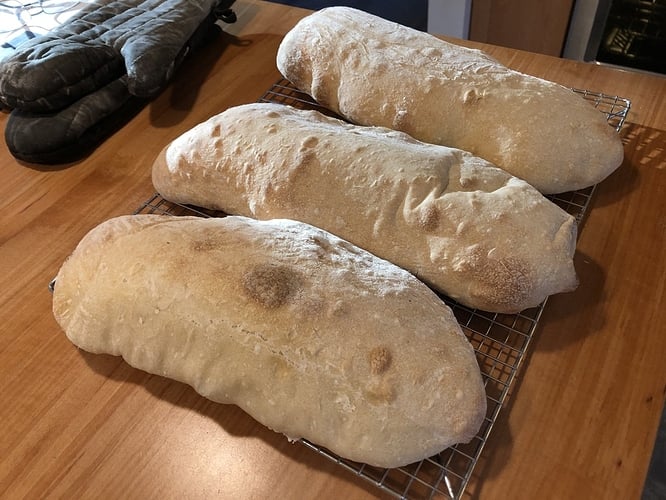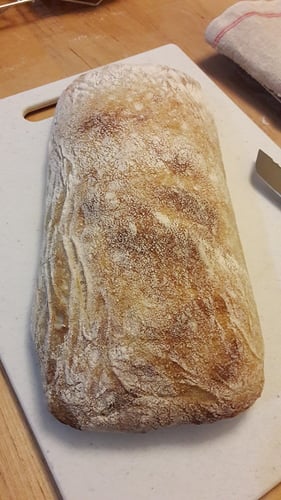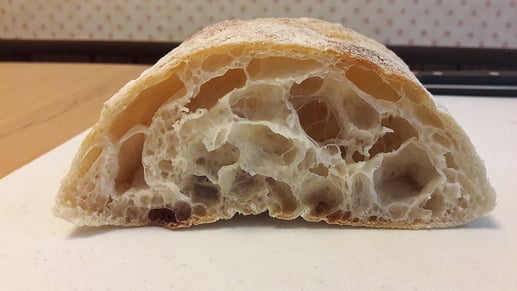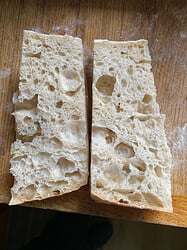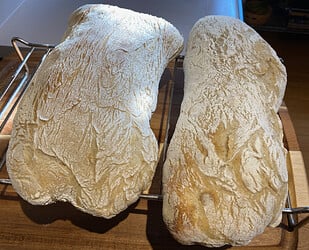Congratulations on baking your first ciabatta loaves! They look pretty good for your first outing! I would echo Melissa’s suggestions to help achieve an open crumb, especially around gluten development (make sure you mix until have a good window pane) and minimal handling after bulk and final proofs. I started getting a much more open crumb when I stopped fussing so much with the dough. One last suggestion: using rice flour on your couche/tea towel for your final proof might help with the sticking problem. I have been using it on my couche and have not had a sticking problem, even though my go-to ciabatta recipe is about 98% hydration. Congratulations again!
So, I’ve kept it up and made this ciabatta three more times. Improvement on some aspect each time. The last time I did it I tried the steam method, rather than trying to get a cover on top of my pizza stone. The first two loaves came out great - I had to delay the third one because I didn’t have enough room in the oven. So, the third one went in, and when I took it out, the pizza stone had cracked in two! Was the steam the culprit? I’m planning to buy a new pizza stone (a bigger one that can take all three loaves at once!) but I’m a little bit afraid of the steam now. Thoughts?
It’s my understanding that ciabatta isn’t shaped at all. High hydration, a good % for coil folds, and when the bulk ferment is done the dough is tipped out of the bowl and with the scraper divided into small oblong pieces of dough. They are then final proofed using a couche after which they are flipped over (that’s important btw) and baked.
I do not think that having steam in the oven would cause your pizza stone to break.
I think the most common cause of cracking for a pizza stone (other than dropping something heavy on it  ) is thermal shock. Could be something like spilling water onto a very hot stone. Also if the stone was wet (where water has soaked into the stone), when the stone heats up to water’s boiling point and steam is produced, the steam pressure could cause breakage. And there is always the possibility of a manufacturing flaw.
) is thermal shock. Could be something like spilling water onto a very hot stone. Also if the stone was wet (where water has soaked into the stone), when the stone heats up to water’s boiling point and steam is produced, the steam pressure could cause breakage. And there is always the possibility of a manufacturing flaw.
When you look for new baking stones, you might want to check out ones made from either Fibrament or Cordierite. They each have better thermal shock resistance than than conventional ceramic stones. Here are some links to some comparisons between these two materials:
https://www.pizzamaking.com/forum/index.php?topic=5645.0
Note that you can purchase fibrament stones in the Breadtopia store.
I use a 20" x 13.5" cordierite stone for my oven. I also use a cordierite stone for baking on my propane grill, since it is rated up to 1800F with excellent thermal shock resistance. Hope this helps!
And glad to hear you are making steady progress on your ciabatta. Practice makes perfect! 
I agree about flipping the final proofed ciabatta before you put them in the oven. This allows the bubbles to redistribute more evenly throughout the loaf. I did a little experiment during one of my recent ciabatta bakes. I flipped 2 of the 3 loaves after final proof but did not flip the last loaf. The first 2 loaves had nicely distributed aveoli, while in the un-flipped loaf all the largest aveoli were at the top of the loaf.
Makes sense. Pan loaves are good but you do see the bubble distribution close to the bottom are different than towards the top. If one is baking freestanding then it does make sense the flipping over redistributes the bubbles more evenly. I mentioned the flipping because I know someone who’s into Italian baking and he really emphasised that.
As I was making this, I was thinking there were too many steps, I was getting too many utensils and bowls dirty, the loaves weren’t looking like they rose enough on the last rise, the couch and the parchment paper seemed unnecessary, then the results were spectacular. The parchment paper step really helped. I got to use my new couche and baking stone. Great smell in the kitchen, great taste, not sour at all.
That was last week. Today I’m going to try baking two loaves and putting one square in the refrigerator for a pizza crust or loaf a few days from now.
Love the story of your experience with the recipe.  Those ciabatta look great!
Those ciabatta look great!
This was my first time making Ciabatta, and this recipe was great! They were definitely a hit at a family birthday bbq. I have one question–a LOT of flour stuck on the ciabattas, especially on the bottoms. After they cooled, I tried to remove as much as I could, but it was still too much! Where did I go wrong?
Yum! The color looks great on those. Maybe use a little less flour on your couche. Though if you’re flipping the ciabatta just before loading them into the oven, it’s more about brushing excess flour off the tops of the ciabatta before putting them in the couche, since the tops become the bottoms.
I debated whether to add this to the “Ciabatta Polesana” topic thread, the “Another interesting way to make a starter” topic thread or to this one, but because it was a soudough ciabatta, I chose this one.
Note that I used Abe’s (@anon44372566) suggestion about creating a starter from basil water to create 2 starters, one using straight basil water for the first feeding (named it Basil Raisefoam) and a second one using half basil water and half lemon juice for the first 3 feedings to jumpstart the acidic environment (named this one Sherlock Foams). Both worked ok, though the second one bypassed the stage where leuconostoc bacteria creates a strong cheesy odor and it was doubling in volume within 3 days and tripling by day 5. I used that one (Sherlock) for this batch, which was the first time I’ve used it in bread.
This is my first try at converting a 98% hydration Ciabatta Polesana recipe from baker’s yeast to sourdough. The original recipe was from Carol Field’s “The Italian Baker”. I used 45% baker’s percentage of a 75% hydration sourdough levain to the final dough, in place of the original yeasted biga. The original recipe used 35% baker’s percentage of biga in the final dough, but I accidentally added the extra 50g of starter to the final dough that I had intended to keep as my ongoing starter. I think it was a happy mistake, however, since most sourdough ciabatta recipes I have seen use 50% - 100% baker’s percentage of
starter to the final dough, so 45% was closer to the norm.
I also needed to reduce the water in the final dough, since the sourdough levain was more extensible than the biga. The resulting total hydration was 95%. It is still a work in process, but I was happy enough with the results for a first try. I’ll continue posting updates as I home in on the final version of the recipe.
That is gorgeous. Reminds me of pan de cristal it’s so open and airy. It makes me want bitey olive oil and jamon serrano.
I’ve also found that the same hydration sourdough dough is more extensible (and silky in texture if that makes sense) than yeast dough. Is this an acid-enzyme sourdough reaction?
Thanks Melissa! I know exactly what you are talking about with the “silky texture” comment. And I also think it is due to the acid-enzyme activity of the sourdough on the gluten.
Why is all purpose flour specified for the poolish? I missed this detail in all the times that I have made this recipe.
When developing this recipe, I read competing arguments about using all purpose vs. bread flour (lower gluten tenderness vs. higher gluten structure). In the end I split the difference and used both. I’m not sure if you’ll notice much if any difference if you use AP flour in your poolish…most likely an increase in extensibility will stand out.
My family wants me to make this recipe a couple times a week. I alternate between this and the artisan rye recipe. I like Bob’s Red Mill bread flour better than King Arthur brad flour for this.
What I am now doing is putting one of the three squares in a plastic bag in the refrigerator to bake a day or two later because we like it so much fresh. Another thing I’m doing in cutting one of the three squares into 3 or 4 pieces to make sandwich rolls. Baking takes 8 minutes on the parchment paper, and 8 minutes off the paper.
Good recipe, thank you. Not baked in a cloche nor were they otherwise covered. I divided the dough into two, not three loaves. I used a combination of whole grain wheat and rye, which accounted for about 15% of the flour volume.
Why is it that sourdough ciabatta recipes always seem to assume I want enough to feed an army? I want a recipe for ONE (1) loaf.
You can halve the recipe to get one slipper/loaf the size of the ones in the comment just before yours, but I did just see some gorgeous looking frozen and defrosted ciabatta in this Instagram post using this recipe. So that’s another option.
I make this recipe a couple times a week. I was getting great looking, great tasting loaves, but the bubbles were too small and regular. What I do now to encourage bigger irregular bubbles is to wait two hours after the second stretch, then the third stretch, then fold and form slippers after three hours. It’s like taking the one and four hour periods and making it 2 and 3 hours. I discovered this by accident and I do it this way every time now for the last couple months.
